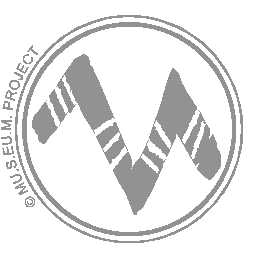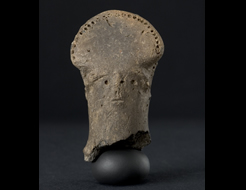|
||||||||||||||||||||||||||||||||
|
|
Museum of: Budapest | |||||||||||||||||||||||||||||||
| Name of the artefact: Idol head fragment with headdress | ||||||||||||||||||||||||||||||||
|
The idol was found in a ritual pit of a vast (220 000
m2) Early Bronze Age settlement. A clay cone was daubed on the bottom of
the pit, into this a pot was dug under which lay six larger stones, most
of them grinding stones. |
||||||||||||||||||||||||||||||||
|
WHERE IS IT AND MAIN
CHARACTERISTICS |
STATE |
|||||||||||||||||||||||||||||||
|
Department: |
Department of Prehistoric and Migration
Period |
Preservation: |
Very good | |||||||||||||||||||||||||||||
|
Inventory number: |
BTM GY/534 |
Restauration: |
Restored | |||||||||||||||||||||||||||||
|
Name of the artefact: |
Idol head fragment with
headdress |
Completeness: |
Complete | |||||||||||||||||||||||||||||
|
Object type: |
Human figurine |
|||||||||||||||||||||||||||||||
|
Material: |
Ceramic with pebbles |
|||||||||||||||||||||||||||||||
|
Methof of manufacture: |
Hand made |
|||||||||||||||||||||||||||||||
|
Decoration
type: |
Incision |
|||||||||||||||||||||||||||||||
|
Distinctive mark: |
- |
|||||||||||||||||||||||||||||||
|
DIMENSIONS |
PERIOD OF USE |
|||||||||||||||||||||||||||||||
|
Length (mm): |
66 |
Epoque: |
Early Bronze Age |
|||||||||||||||||||||||||||||
|
Heigth
(mm): |
- |
Culture: |
Makó culture |
|||||||||||||||||||||||||||||
|
Diameter
(mm): |
28 |
Period: |
Early Bronze Age 2 |
|||||||||||||||||||||||||||||
|
Width (mm): |
- |
Face: |
Late |
|||||||||||||||||||||||||||||
|
Thickness (mm): |
- |
Absolute chronology: |
2500-2200 BC |
|||||||||||||||||||||||||||||
|
Weight
(g): |
- |
|||||||||||||||||||||||||||||||
DISCOVERY |
||||||||||||||||||||||||||||||||
|
Date: |
2003 |
Country: |
Hungary |
|||||||||||||||||||||||||||||
|
District: |
Budapest, XI |
Town hall affiliation: |
- |
|||||||||||||||||||||||||||||
|
Village: |
- |
Discovery findspot: |
Budapest, Kőérberek |
|||||||||||||||||||||||||||||
|
Condition of discovery: |
Archaeological excavation |
Discovery type: |
Pit |
|||||||||||||||||||||||||||||
|
ANALYSES – DETERMINATIONS |
FILLED IN BY |
|||||||||||||||||||||||||||||||
|
Type: |
- |
Name: |
László Reményi |
|||||||||||||||||||||||||||||
|
Laboratory: |
- |
Institution: |
Budapest History Museum |
|||||||||||||||||||||||||||||
|
No./Code: |
- |
Date: |
20/10/2005 |
|||||||||||||||||||||||||||||
|
DEEPENINGS |
||||||||||||||||||||||||||||||||
|
Morphology of the object: |
||||||||||||||||||||||||||||||||
|
Although the body of the idol is missing, based on its
cylindrical neck and the widening at the surface of the fracture it
belongs to the cylindrical bodied group of idols. The head is represented
by the face depicted on the upper part of the cylindrical neck, while a
semicircular headdress connects to it. The features of the idol are
realistic: the eyes, mouth, nose, and even the nostrils are well
discernable. The upper part of the face is framed by the elongated curve
of the eyebrows in relief. The ears are portrayed realistically as well,
the hole representing the ear-hole bordered by a semicircular pricked-in
rib. The headdress is separated from the head by the incised line drawn
above the eyebrows, which continues behind the ears after a break,
probably representing a diadem. The semicircular headdress connects to the
head with an almost 45 degree angle. The semicircular part is framed in
front by a line made up of 25 punched dots. From the vertex of the
semicircular arch a prominent ridge runs along the reverse side, which
curves across the whole head. The ridge could belong either to the
headdress, holding it up from the rear end, or represents plaited hair.
|
||||||||||||||||||||||||||||||||
|
Decoration: |
||||||||||||||||||||||||||||||||
|
- |
||||||||||||||||||||||||||||||||
|
Inscription: |
||||||||||||||||||||||||||||||||
|
- |
||||||||||||||||||||||||||||||||
|
Analogies: |
||||||||||||||||||||||||||||||||
|
Börzönce, Nagybörgő, Dörgicse (Hungary). Headdress:
Franzhausen I.cemetery |
||||||||||||||||||||||||||||||||
|
Interpretation: |
||||||||||||||||||||||||||||||||
|
A similar headdress was found in grave 110. of the
Early Bronze Age Franzhausen I. cemetery. A woman buried with a wealth of
metal objects had a headdress on her skull made of two larger metal sheets
bent in the middle, onto which 25 pieces of smaller metal sheets with
punched decoration were inflected. The headdress is formally the
equivalent of that of the idol from Kőérberek. In the grave the skull had
a copper diadem, which lets us conclude that the line running along the
forehead of the idol’s head represents a diadem. The skeleton in the grave
had several earrings near the ear, which may let us interpret the dotted
lines framing the ears as depicting earrings. The idol of Kőérberek
represented an individual of outstanding status. |
||||||||||||||||||||||||||||||||
|
Bibliography: |
||||||||||||||||||||||||||||||||
|
Horváth, L. A., Korom, A., Terei, Gy., Szilas, G.,
Reményi, L., Előzetes jelentés az épülő Kőérberek, Tóváros-Lakópark
területén folyó régészeti feltárásról. Preliminary report on the
archaeological excavation conducted parallel to the construction on the
territory of the Kőérberek, Tóváros Residental District. Aquincumi Füzetek
11 (2005), p. 137-167. Bondár, M., Early Bronze Age Settlement Pattern in
Southwest Transdanubia. Antaeus 22(1995), p. 197-268. Neugebauer, Ch. –
Neugebauer, J-W. 1997 Franzhausen das frühbronzezeitliche Graberfeld I. FÖ
Materialhett A 5. Wien 1997. |
||||||||||||||||||||||||||||||||

